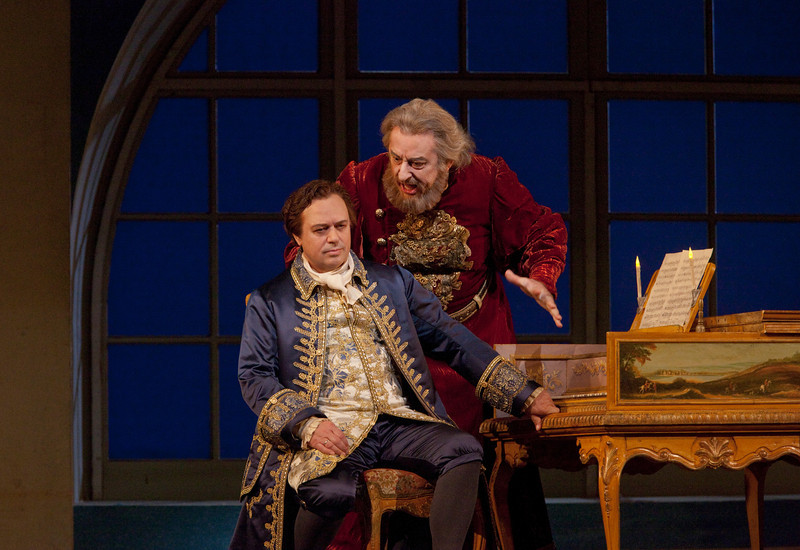The Met’s “Khovanshchina” proves a bleak yet powerful experience

Vladimir Galouzine as Vasily Golitsyn and Anatoli Kotscherga as Ivan Khovansky in Mussorgsky’s “Khovananshchina.” Photo: Ken Howard/Metropolitan Opera
In the department of doom and gloom, Mussorgsky’s Khovanshchina takes the top prize. Set in Moscow in the years before Peter the Great ascended the throne, it paints a frighteningly pessimistic picture of a Russia of illiterate strongmen, irresponsible aristocrats and impotent religious leaders. The score, left unfinished at the composer’s death by alcohol poisoning, is fittingly dark, dominated by bass voices and a choir that moves back and forth from desperate prayer to orgies of drink and violence.
Any glimmer of hope needs to be provided by the viewer who may, if inclined towards a melioristic view of history, see the plot as justification for Tsar Peter’s ruthless modernization efforts, which determined the country’s character to this day. Rimsky-Korsakov and Shostakovitch, who each fashioned a performance edition of the score, took that view when they reprised the tender sunrise prelude from the opera’s opening at the end, linking the new tsar with the image of dawn.
In Monday night’s revival of August Everding’s 1985 production, the Metropolitan Opera for the first time used the final scene composed by Stravinsky and Ravel based on sketches by Mussorgsky, which concludes the opera with a hushed, hopeless plea for peace. Aided by a stellar lineup of Russian and Georgian voices including the magnificently deep-hued mezzo of Olga Borodina, the Met may well congratulate itself on presenting the darkest Khovanshchina mounted to date.
In keeping with the nihilistic mood, the production takes no stand on the power struggles between modernizers and reactionaries in seventeenth-century Russia, nor does it seek to connect and reconcile the past with the present. Set designer Ming Cho Lee, offering a plywood Kremlin, plywood barracks, and a plywood church, also seems determined to keep the action at arm’s length. Interior scenes take place in small rectangular boxes set inside a vast black wall creating the effect of peering into a dollhouse.
The voices, at least, were life-size. In a work dominated by deep voices, Ildar Abdrazakov’s smooth, lyric bass functioned as one of two magnetic poles. In the role of Dosifei, the spiritual leader of the Old Believers, a conservative sect persecuted after a schism in the Orthodox church, he brought an aristocratic polish to the roaming, prayer-like phrases.
His counterpart was fellow Russian bass Anatoli Kotscherga making his house debut as the blustering Prince Ivan Khovansky, whose alleged conspiracy to usurp the throne gives the opera its title. Unlike Abdrazakov, Kotscherga’s is a true powerhouse bass, capable of belting out commands and bringing a bully’s menace to even the most quiet phrase. Towering over the other singers, Kotscherga also stood out as the most subtle actor of them all. During the Dance of the Persian Slaves, given a gracefully erotic new choreography by Benjamin Millepied, he played a strongman made clumsy with desire as he groped after the masked young dancers, half leering, half apologizing for his oafishness.
Baritone George Gagnidze was Shaklovity, the boyar whose machinations lead to Khovansky’s death. He was a convincing tough in the first scene, where he intimidates a scribe into writing the anonymous denunciation with just the right amount of roughness in his voice. In a later aria lamenting the fate of Russia, the singer brought a note of Verdian sophistication.
Of the two principal tenors, Vladimir Galouzine as Prince Vasily Golitsyn had the more polished delivery and a satisfying amount of deep color; Misha Didyk as Khovansky’s son Prince Andrei had just as much power and a clarion timbre, but tended to over-sing.
As Emma, a young Protestant girl pursued by the Khovansky père et fils, Wendy Bryn Harmer sounded uncharacteristically shrill. It was left to Borodina as Marfa, the enigmatic fortune teller, Old Believer and incorrigible lover of Andrei, to carry the women’s torch. Her voice has gotten heavier over the years – she recently lamented the fact that she can no longer sing Rossini – but what her lower register has gained in resonance and beauty more than makes up for any loss of nimbleness. Her incantation scene was lovingly pared back, allowing other more passionate exchanges to glow. Her character remains a mystery – why she loves a man as gutless as Andrei, or joins as ascetic a sect – but without her, the final scene in which the Old Believers commit mass suicide by self-immolation would make even less sense.
Conductor Kirill Petrenko did not add much by way of clarification or comment, leading a nicely focused performance of a score that, with exceptions like the Dance of the Slaves and some finely wrought choral passages, contents itself with a limited and somber color palette.
Khovanshchina continues at the Metropolitan Opera through March 17. metopera.org; 212-362-6000
Posted Mar 01, 2012 at 6:24 pm by Vladimir P. Fekula
Absolutuly a first rate pruduction. Borodina was amazing with a golden Mezzo voce that beamed throughout the Met Opera House. Conducting was superb. A totally moving and inspirational evening to usher in the first day of the Great Lent in the Orthodoc hurch. Lastly, the Met Chorus thundered.